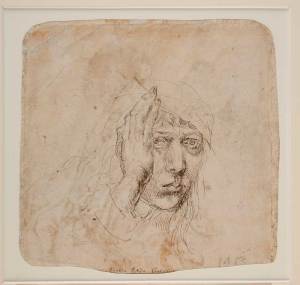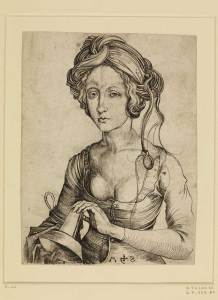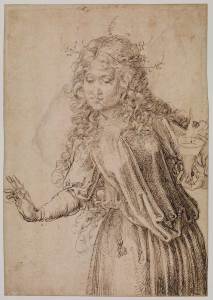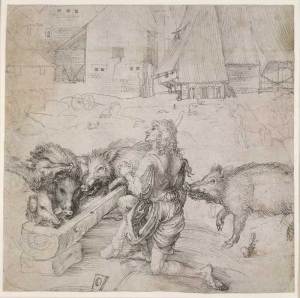‘The Young Dürer: Drawing the Figure’ at the Courtauld Gallery is worth seeing if only to clear up some facts about the artist’s life. He can be a difficult figure to place, as Vasari himself found. He refers to him in Lives of the Artists, but muddled up the section about Dürer’s background:
[If] this man, so able, so diligent, and so versatile, had had Tuscany instead of Flanders for his country, and he had been able to study the treasures of Rome, … he would have been the best painter of our land, even as he was the rarest and most celebrated that has ever appeared among the Flemings.

Self-portrait (verso; c.1491–2), Albrecht Dürer, Graphische Sammlung der Universitat, Erlangen
Vasari believed Dürer to be from Antwerp and a member of the Flemish school, but in fact he grew up in Nuremberg. Most scholars also agree that he was exposed to Italian work – but the Venetian tradition, rather than the Tuscan one. Given that Vasari’s classifications have continued to have such an impact on the critical history of Renaissance art (quite often to the subject’s detriment), it is understandable that some confusion about Dürer perpetuates.
Dürer was trained in the German printmaking tradition before embarking on a Wanderjahre in 1490 at the age of 19, during which he studied at various artists’ workshops throughout Europe. He was not a child prodigy – some dubious foreshortening and stiff drapery studies make that clear – but he did return from his travels in 1495 as a highly accomplished artist, engaged with both Italian and Northern artistic traditions.

A Foolish Virgin in half-length ( c.1470–1482), Martin Schongauer © The Trustees of the British Museum, London
The exhibition includes work by several artists that Dürer studied, collected and copied. The engraver Martin Schongauer is included, as is Michael Wolgemut, and mysterious figures like the Master of the Drapery Studies and the Housebook Master. Not grandiose names, but nonetheless, important figures in Dürer’s development.
Jonathan Jones has criticised the exhibition for its ‘academic introspection’ and ‘snobbish connoisseurship’. He says that ‘Dürer’s very artistic personality disintegrates under this pedantic scrutiny’. But the Courtauld is right to subject him to close scrutiny. Only by inspecting his juvenilia and seeing his rapid progress, can you understand why he surpassed the school he came from.
There is also good reason for the show’s scholarly atmosphere. It is part of a comprehensive four-year research project in collaboration with various European institutions including the Germanisches Museum, who last year showcased the exhibition ‘The Early Dürer’ in Nuremberg. The project explores the circumstances of Dürer’s early development. Against this backdrop (which Jones fails to mention), the Courtauld’s measured approach makes more sense.

A Wise Virgin (recto; 1493), Albrecht Dürer, Samuel Courtauld Trust, The Courtauld Gallery, London
The show gently segues into Dürer’s appropriation of the classical style, and compares his more Gothic works such as A Wise Virgin (1493) and The Holy Family with a Dragonfly (1495) with pieces such as The Prodigal Son (c.1495–6). As Katherine Crawford Luber wrote (and this exhibition demonstrates), he was ‘a living conduit for the exchange of artistic ideals and theories between the two cultures’.
A complementary exhibition in the adjacent room looks at the works that Aby Warburg included in his 1905 lecture on ‘Dürer and Italian Antiquity’. It includes his early drawing The Death of Orpheus (1494) as well as the celebrated engravings Melancholia I (1514) and Nemesis (c.1502) and four prints by Andrea Mantegna. Jones has previously referred to Melancholia as a ‘masterpiece’ that has ‘cut its black lines deep into the modern imagination’. Why he chose to ignore the fact that the Courtauld secured this work for the show is baffling. It confirms Dürer’s formidable development as an artist, and is all the more startling when seen alongside his early, embryonic works.

The Prodigal Son (c.1495–96), Albrecht Dürer © The Trustees of the British Museum, London
If you come to the show wanting to see only Dürer, you will be disappointed. A blockbuster would be magnificent, but this is not meant to be one. It is a thoughtful exhibition, supported by a comprehensive catalogue, which helps to untangle some of Dürer’s early influences. Visit with your connoisseur’s hat on, and you may find it all the more refreshing.
‘The Young Dürer: Drawing the Figure’ is at the Courtauld Gallery, London, until 12 January 2014.

Under Scrutiny
Self-portrait (verso; c.1491–2), Albrecht Dürer, Graphische Sammlung der Universitat, Erlangen
Share
‘The Young Dürer: Drawing the Figure’ at the Courtauld Gallery is worth seeing if only to clear up some facts about the artist’s life. He can be a difficult figure to place, as Vasari himself found. He refers to him in Lives of the Artists, but muddled up the section about Dürer’s background:
[If] this man, so able, so diligent, and so versatile, had had Tuscany instead of Flanders for his country, and he had been able to study the treasures of Rome, … he would have been the best painter of our land, even as he was the rarest and most celebrated that has ever appeared among the Flemings.
Self-portrait (verso; c.1491–2), Albrecht Dürer, Graphische Sammlung der Universitat, Erlangen
Vasari believed Dürer to be from Antwerp and a member of the Flemish school, but in fact he grew up in Nuremberg. Most scholars also agree that he was exposed to Italian work – but the Venetian tradition, rather than the Tuscan one. Given that Vasari’s classifications have continued to have such an impact on the critical history of Renaissance art (quite often to the subject’s detriment), it is understandable that some confusion about Dürer perpetuates.
Dürer was trained in the German printmaking tradition before embarking on a Wanderjahre in 1490 at the age of 19, during which he studied at various artists’ workshops throughout Europe. He was not a child prodigy – some dubious foreshortening and stiff drapery studies make that clear – but he did return from his travels in 1495 as a highly accomplished artist, engaged with both Italian and Northern artistic traditions.
A Foolish Virgin in half-length ( c.1470–1482), Martin Schongauer © The Trustees of the British Museum, London
The exhibition includes work by several artists that Dürer studied, collected and copied. The engraver Martin Schongauer is included, as is Michael Wolgemut, and mysterious figures like the Master of the Drapery Studies and the Housebook Master. Not grandiose names, but nonetheless, important figures in Dürer’s development.
Jonathan Jones has criticised the exhibition for its ‘academic introspection’ and ‘snobbish connoisseurship’. He says that ‘Dürer’s very artistic personality disintegrates under this pedantic scrutiny’. But the Courtauld is right to subject him to close scrutiny. Only by inspecting his juvenilia and seeing his rapid progress, can you understand why he surpassed the school he came from.
There is also good reason for the show’s scholarly atmosphere. It is part of a comprehensive four-year research project in collaboration with various European institutions including the Germanisches Museum, who last year showcased the exhibition ‘The Early Dürer’ in Nuremberg. The project explores the circumstances of Dürer’s early development. Against this backdrop (which Jones fails to mention), the Courtauld’s measured approach makes more sense.
A Wise Virgin (recto; 1493), Albrecht Dürer, Samuel Courtauld Trust, The Courtauld Gallery, London
The show gently segues into Dürer’s appropriation of the classical style, and compares his more Gothic works such as A Wise Virgin (1493) and The Holy Family with a Dragonfly (1495) with pieces such as The Prodigal Son (c.1495–6). As Katherine Crawford Luber wrote (and this exhibition demonstrates), he was ‘a living conduit for the exchange of artistic ideals and theories between the two cultures’.
A complementary exhibition in the adjacent room looks at the works that Aby Warburg included in his 1905 lecture on ‘Dürer and Italian Antiquity’. It includes his early drawing The Death of Orpheus (1494) as well as the celebrated engravings Melancholia I (1514) and Nemesis (c.1502) and four prints by Andrea Mantegna. Jones has previously referred to Melancholia as a ‘masterpiece’ that has ‘cut its black lines deep into the modern imagination’. Why he chose to ignore the fact that the Courtauld secured this work for the show is baffling. It confirms Dürer’s formidable development as an artist, and is all the more startling when seen alongside his early, embryonic works.
The Prodigal Son (c.1495–96), Albrecht Dürer © The Trustees of the British Museum, London
If you come to the show wanting to see only Dürer, you will be disappointed. A blockbuster would be magnificent, but this is not meant to be one. It is a thoughtful exhibition, supported by a comprehensive catalogue, which helps to untangle some of Dürer’s early influences. Visit with your connoisseur’s hat on, and you may find it all the more refreshing.
‘The Young Dürer: Drawing the Figure’ is at the Courtauld Gallery, London, until 12 January 2014.
Share
Recommended for you
Ideal Man
The Musée d’Orsay’s exhibition of male nudes is almost a great show, but it misses a timely opportunity to explore homoerotic sentiment in art
Across the Pond
An exhibition at the Dulwich Picture Gallery attempts to find a home for Whistler on the banks of the Thames
The Modern Way
‘California Design 1930–1965: Living in a Modern Way’ has spent two years skirting the edges of the Pacific Ocean, and just landed in Brisbane